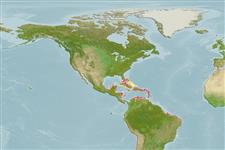Common names from other countries
Classification / Names / Names
народные названия | синонимы | Catalog of Fishes (gen., sp.) | ITIS | CoL | WoRMS
Environment: milieu / climate zone / depth range / distribution range
экология
; солоноватоводный; пределы глубины 1 - 2 m (Ref. 86836). Tropical; 25°C - 33°C (Ref. 86836)
Western Central Atlantic.
Length at first maturity / Size / Вес / Возраст
Maturity: Lm ? range ? - ? cm Max length : 1.0 cm OT самец/пол неопределен; (Ref. 415)
Massive lobate to ramose. Color: dark green externally, lighter internally. Surface smooth with oscular chimneys; 0.5 - 1 cm diameter. The species is compressible but crumbly in consistency (Ref. 415).
Maximum surface diameter: 1 cm (Ref. 415). Depth range from Belize (Ref. 086836). Common on shallow reefs, seagrass beds, and mangroves (Ref. 415).
Life cycle and mating behavior
половая зрелость | размножение | нерест | икра | Fecundity | личинки
Members of the class Demospongiae are hermaphroditic. Life cycle: The zygote develops into parenchymella larva (free-swimming) before settling down on a substrate where it grows into a young sponge.
Основная ссылка
ссылки | координатор | соавторы
Collin, R., M.C. Díaz, J. Norenburg, R.M. Rocha, J.A. Sánchez, M. Schulze, A. Schwartz and A. Valdés. 2005. (Ref. 415)
Статус Красного Списка МСОП (Ref. 130435)
Статус СИТЕС (Ref. 108899)
Not Evaluated
Not Evaluated
Угроза для людей
Harmless
Использование человеком
| FishSource |
инструменты
дополнительная информация
ресурсы в Интернет
Estimates based on models
Preferred temperature
(Ref.
115969): 26.3 - 28.4, mean 27.4 (based on 151 cells).
Уязвимость
Low vulnerability (10 of 100).
Категория цены
Unknown.
